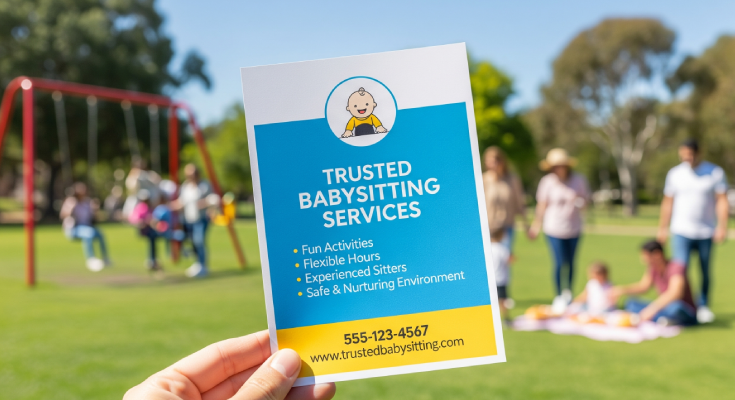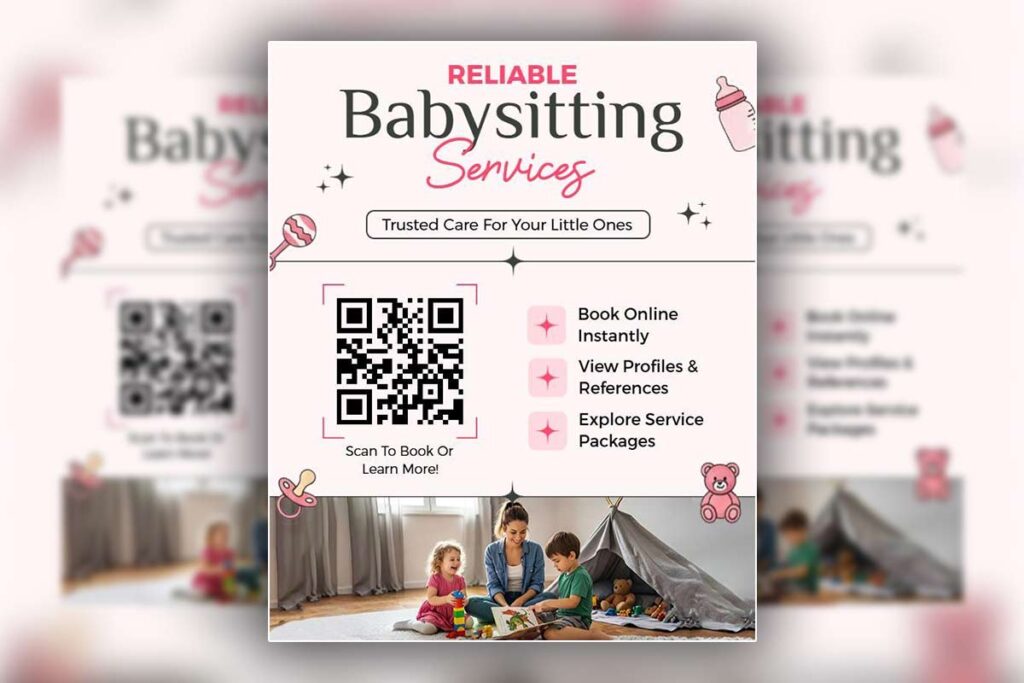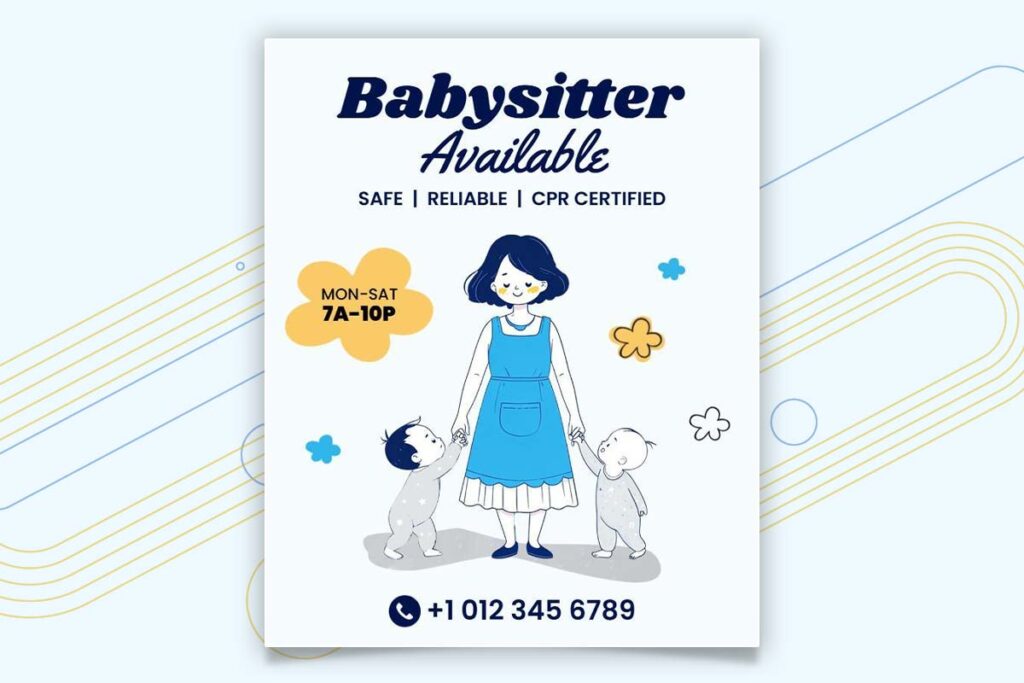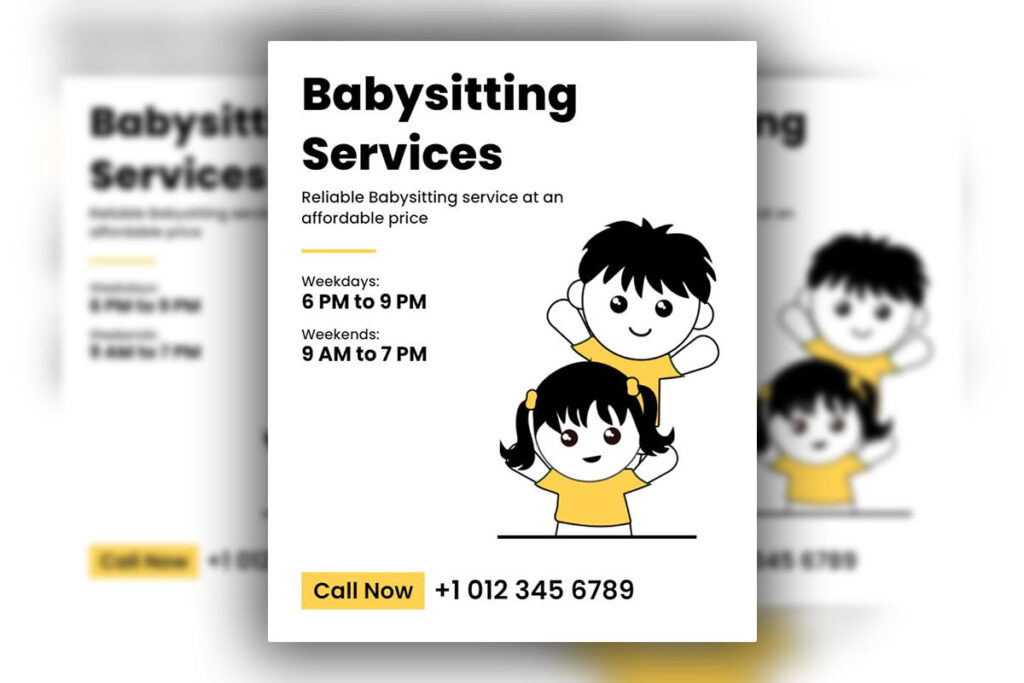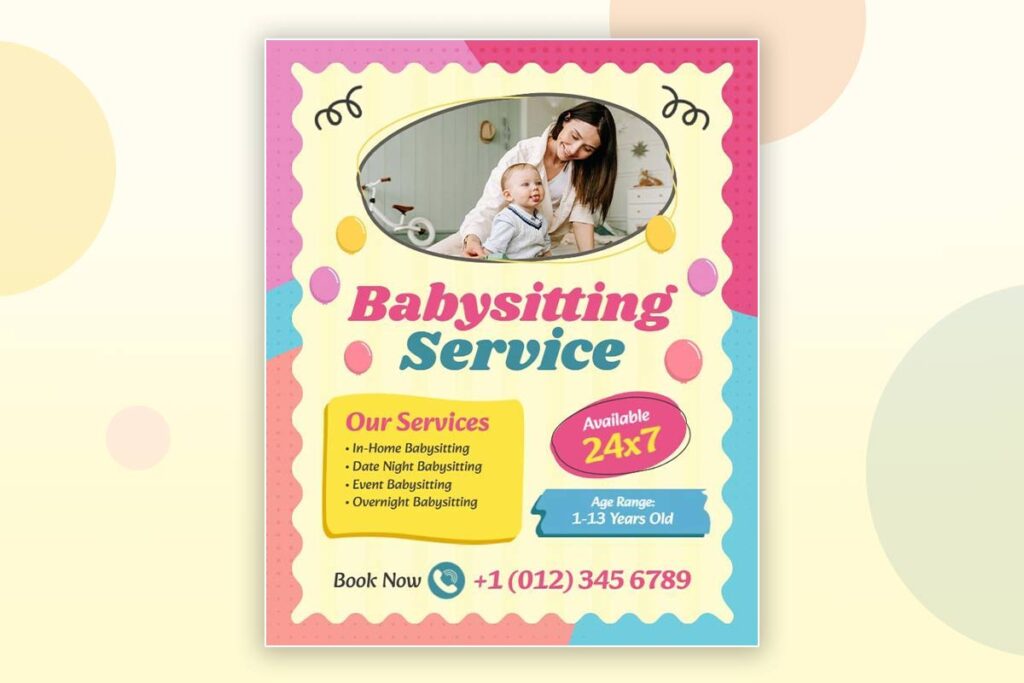Most babysitting territory flyers fail because creators overlook strategic distribution fundamentals that separate amateur from professional results in new neighborhoods. Effective flyer distribution combines babysitting territory strategies with targeted placement for immediate visibility. Choosing the right flyer templates ensures design consistency and credible messaging.
Successful implementation requires knowing how to create a flyer that aligns with service goals and neighborhood expectations. Quality distribution also demands systematic babysitting advertisement flyers combined with service expansion expertise for optimal results. A well-placed babysitting flyer establishes trust and generates inquiries using evidence-based timing and location strategies.
This guide delivers practical techniques for expanding your babysitting service area through effective flyer campaigns. Territory expansion success requires understanding parent traffic patterns, optimal placement locations, and messaging that resonates with unfamiliar communities seeking reliable childcare providers.
How Do Babysitting Territory Flyers Help Establish Presence In New Neighborhoods?
Babysitting territory flyers serve as powerful introductory tools that create immediate recognition and trust in unfamiliar neighborhoods. These babysitting service flyers showcase your credentials, experience, and availability directly to potential families who haven’t heard of your services. By strategically distributing babysitting advertisement flyers in targeted areas, you build local awareness before word-of-mouth takes effect. The physical presence of professionally designed flyers demonstrates commitment to serving the community, while contact information enables easy inquiries. Territory flyers bridge the gap between being unknown and becoming the go-to childcare provider families remember when babysitting needs arise.
Building Initial Trust Through Professional Presentation in Unknown Areas
Professional babysitting territory flyers instantly establish credibility through visual presentation and content quality. High-quality design, clear headshots, and certification displays signal professionalism to parents evaluating unknown childcare providers. Neighborhood-specific messaging that references local schools, parks, or landmarks demonstrates genuine community knowledge and investment.
Service area maps showing precise coverage boundaries help families understand your availability while building confidence in your organizational skills. Emergency contact protocols and background check certifications address primary safety concerns skeptical parents harbor about unfamiliar babysitters. Professional testimonials from established areas provide social proof that overcomes initial hesitation about hiring unknown providers.
Quality marketing materials distinguish serious childcare professionals from casual occasional babysitters. Parents equate flyer design quality with service reliability, making professional presentation essential for territory expansion success.
Creating Name Recognition Before Establishing Local Referral Networks
Territory flyers create essential name recognition months before referral networks develop naturally. Consistent branding across promotional materials builds familiarity through repeated exposure, making your name memorable when parents discuss childcare options with neighbors.
Strategic distribution timing during high-parent traffic periods maximizes visibility and recall. School pickup zones, community centers, and local businesses provide targeted exposure to your ideal client base. Regular distribution schedules reinforce name recognition without overwhelming neighborhoods with excessive promotional content.
Geographic consistency helps families associate your brand with reliable local service. When emergency childcare needs arise, parents recall professionally presented flyers over casual word-of-mouth recommendations from unknown sources. Early brand establishment creates competitive advantages against providers entering your territory later.
Demonstrating Service Commitment to Skeptical New Communities
Territory expansion requires overcoming natural community skepticism about outsiders providing childcare services. Babysitting flyer distribution demonstrates genuine investment in serving new neighborhoods through time, effort, and financial resources committed to marketing presence.
Local advertising materials signal long-term service commitment rather than temporary availability. Parents appreciate providers who invest in understanding their specific neighborhood dynamics, school schedules, and community events. Customized messaging addressing local concerns shows dedication beyond generic service offerings.
Professional babysitting service flyer template indicates established business operations capable of sustained service delivery. Multi-contact options including phone, text, and email provide accessibility preferences modern families expect. Service guarantee statements and established pricing demonstrate business legitimacy that builds confidence with cautious parents.
Regular flyer updates with fresh testimonials, new certifications, or expanded services show active business growth and community engagement. This ongoing marketing presence reinforces your commitment to serving the neighborhood professionally while competitors rely solely on word-of-mouth development.
- Community Center Babysitting Nights Flyer Template
- Babysitter Community Service Promotion Flyer Template
What Design Elements Make Babysitting Territory Flyers Effective For Area Expansion?
Effective babysitting business flyers for territory expansion require location-specific design elements that resonate with new communities. Clear service area maps showing coverage zones help families understand availability, while local landmark references build immediate connection. Professional headshots and credential displays establish credibility in unfamiliar markets. Bold contact information with multiple communication options ensures easy reach. Babysitting promotional flyers should feature flexible scheduling graphics and emergency availability indicators that address common childcare concerns. Color schemes and fonts must appear trustworthy yet approachable, while testimonial sections from existing clients provide social proof that overcomes initial hesitation about hiring unknown providers. Specialists looking to make their flyers more effective can learn how to design babysitting flyers to capture attention and build trust with new families.
- Playful Yellow Babysitting Services Flyer Template
- Playful Blue Denim Babysitting Services Flyer Template
Geographic Mapping Features That Clarify Service Boundaries
Babysitting territory flyers must include clear visual maps showing exact service boundaries within new neighborhoods. Coverage area maps eliminate confusion about whether your services extend to specific streets or subdivisions. Use distinctive borders highlighting your current service zones with dotted lines indicating expansion areas. Include local landmarks like schools, shopping centers, and community centers that parents recognize immediately. Geographic elements should feature neighborhood names, major streets, and approximate travel times from your base location. Distance indicators showing “within 15 minutes” or “5-mile radius” provide concrete availability expectations. Professional babysitting service flyers benefit from simple, clean map designs that avoid overwhelming detail while maintaining geographic accuracy that builds trust through transparency.
Credibility Indicators That Overcome New Market Skepticism
New neighborhoods require enhanced credibility elements since parents lack referral networks for unfamiliar babysitting service providers. Professional headshots establish personal connection while background check certifications address primary safety concerns. Display relevant qualifications prominently including CPR certification, first aid training, and childcare experience years. Testimonial sections featuring previous clients build social proof without requiring local references. Include age specialization graphics showing comfort levels with infants, toddlers, or school-age children. Emergency preparedness indicators like hospital familiarity and parent communication protocols demonstrate professional preparedness. The Contact information should include multiple verification methods like LinkedIn profiles or professional references that parents can independently validate before initial meetings.
Contact Accessibility Design for Immediate Response Generation
Contact sections require maximum accessibility since territory expansion depends on converting inquiries quickly. Phone numbers should appear in large, bold fonts with click-to-call functionality for mobile viewing. Multiple communication options including text messaging, email, and social media handles accommodate different parent preferences. QR codes linking to online booking systems streamline scheduling processes for tech-savvy families. Response time commitments like “replies within 2 hours” set clear expectations that encourage initial contact. Include availability calendars or scheduling links that eliminate phone tag frustrations. Emergency contact information should remain visible even when regular services aren’t available. Best babysitting flyer distribution strategies emphasize placing contact details at both top and bottom positions for maximum retention. Professional email addresses using custom domains rather than generic services enhance credibility perceptions essential for babysitting client acquisition flyers in competitive suburban markets.
- Playful Blue Babysitting Service Childcare Flyer Template
- Playful Pink Babysitting Services Advertisement Flyer Template
Where Should You Distribute Babysitting Territory Flyers For Maximum Visibility?
Strategic distribution locations for babysitting territory flyers include community centers, pediatrician offices, and school pickup zones where parents naturally congregate. Libraries with children’s sections, local coffee shops, and neighborhood grocery stores offer high parent traffic, and targeting the right spots can be easier with babysitting flyer distribution tips. Target apartment complexes and new housing developments where families are actively seeking childcare services. Preschools and daycares often allow babysitting service flyers on community boards. Consider recreational facilities like playgrounds and youth sports venues where parents gather regularly. Focus on areas with heavy foot traffic during morning school runs and evening pickup times when parents are most receptive to childcare solutions.
High-Traffic Parent Gathering Locations for Flyer Placement
Schools and daycare centers provide prime placement opportunities during drop-off and pickup times when parents are focused on childcare logistics. Pediatrician offices and urgent care centers allow babysitting advertisement flyers where anxious parents wait and consider backup childcare options. Libraries with children’s programs attract engaged parents seeking enrichment activities for their kids. Coffee shops near elementary schools capture parents during morning routines or afternoon pickups. Grocery stores with family-friendly layouts and kid-focused sections provide extended exposure time as parents shop. Youth sports complexes and recreational centers gather parents regularly, creating repeated exposure opportunities. Fitness centers with childcare services attract health-conscious parents who value quality caregiving. Position babysitting business flyers at eye level in designated community areas, ensuring compliance with location policies while maximizing visibility during peak parent traffic hours for optimal response rates.
Residential Complex Distribution Strategies for New Territory Coverage
Apartment complexes and condominiums require strategic placement in mailroom areas, elevator lobbies, and community bulletin boards where residents check daily. New housing developments provide concentrated access to families establishing childcare networks in unfamiliar neighborhoods. Homeowner associations often maintain community boards accepting babysitting promotional flyers with proper approval. Target family-oriented neighborhoods with visible playgrounds, sidewalks with strollers, and school bus stops indicating high child populations. Suburban subdivisions with newer construction attract young families needing reliable babysitting services. Multi-family housing near schools provides access to parents balancing work and childcare responsibilities. Door-to-door distribution in select neighborhoods creates personal touchpoints, though requires careful attention to solicitation regulations and homeowner preferences. Focus on timing distribution around school schedules when parents are home and planning weekly childcare needs, ensuring maximum visibility and response potential.
Community Board Networks That Welcome Babysitting Service Advertisements
Community centers serve as information hubs where parents research local services, programs, and childcare options regularly. Churches and religious organizations maintain family-focused bulletin boards welcoming babysitting flyer distribution methods that serve congregation members. Local businesses like pharmacies, dry cleaners, and banks often provide community bulletin spaces as customer service features. Neighborhood associations and civic groups maintain communication boards for resident services and local business promotion.
Parent-teacher organizations at schools frequently allow babysitting service area expansion flyers that benefit their member families. Youth organizations including scouts, sports leagues, and activity clubs provide access to families already investing in children’s programming. Senior centers serve grandparents seeking babysitting referrals for visiting grandchildren or family events requiring childcare support.
Professional networking groups attract working parents needing reliable childcare solutions for business events and professional obligations. Mom’s groups and parenting organizations actively share resource information including trusted babysitting client acquisition flyers. Real estate offices serve families relocating who need immediate childcare connections in new neighborhoods. Establish relationships with board coordinators, understand posting schedules and requirements, and maintain professional presentation standards that reflect positively on your babysitting local advertising materials across all community networks for sustained visibility and trust-building opportunities.
How Can Babysitting Territory Flyers Compete With Digital Marketing In New Areas?
Babysitting territory flyers compete with digital marketing through immediate physical presence that establishes local credibility without algorithm dependencies or advertising costs. Physical flyers create tangible neighborhood connections that parents can reference when childcare needs arise. They overcome digital saturation by providing direct contact information families keep accessible. Strategic placement in high-parent-traffic locations ensures targeted reach to families actively seeking childcare services, while babysitting flyer platforms give digital-savvy sitters additional ways to blend print and online visibility.
Multiple studies show traditional media remain effective in contemporary business environments, particularly for service-based businesses establishing local market presence.1
- Online Babysitting Service Promotion Flyer Template
- Comprehensive Babysitting Services Flyer Template
Building Local Trust Through Physical Presence Marketing
Physical babysitting service flyers create immediate neighborhood credibility through tangible community presence. Parents can evaluate credentials, contact information, and service offerings at their convenience without internet connectivity or device requirements. Flyers posted on community bulletin boards demonstrate commitment to serving local families rather than casting wide digital nets. This local visibility builds recognition before word-of-mouth referrals develop. Parents prefer childcare providers who show investment in their specific community through physical marketing materials rather than generic online advertisements.
- Trusted Babysitting Services Promotional Flyer Template
- Trusted Babysitting Services Advertisement Flyer Template
Cost-Effective Territory Establishment Without Digital Dependencies
Babysitting advertisement flyers eliminate expensive digital advertising costs while reaching target audiences directly. No monthly ad spend, algorithm changes, or platform dependencies affect visibility. Printing and distribution costs remain predictable and controllable compared to fluctuating digital advertising rates. Territory expansion requires minimal upfront investment versus establishing online presence across multiple platforms. Babysitting business flyers provide unlimited exposure duration unlike time-limited digital campaigns. Local posting locations offer consistent visibility without ongoing monthly expenses or competitive bidding systems, making cost-effective flyer strategies for new babysitters a practical solution for new sitters.
- Affordable Babysitting Services Flyer Template
- Affordable Babysitting and Childcare Service Flyer Template
Tangible Contact Solutions That Outperform Online Advertising Noise
Babysitting promotional flyers provide instant contact accessibility that parents can reference during childcare emergencies or planning sessions. Physical contact cards remain visible on refrigerators and bulletin boards when digital ads disappear after viewing. Parents can quickly access phone numbers without searching through online platforms or social media feeds. Flyers overcome digital advertising fatigue by standing out through tactile design elements and local geographic specificity. They establish authentic connections through community board placement where parents actively seek local service providers. Professional babysitting service flyers design creates memorable visual recognition that digital ads struggle to achieve in saturated online environments. Strategic distribution timing during school pickup hours ensures visibility when parents actively consider childcare solutions.
What Content Should Babysitting Territory Flyers Include For Geographic Expansion?
Effective babysitting territory flyers for geographic expansion require location-specific content that builds immediate trust with unfamiliar families. Essential elements include clear service area maps showing exact coverage zones, local contact information, and neighborhood-specific messaging that demonstrates community commitment. Professional credentials, background check certifications, and testimonials from existing service areas establish credibility when parents have no prior referrals. Include specific age groups served, emergency qualifications, and unique services like homework help or meal preparation that differentiate your offerings from local competitors.
Coverage Area Maps and Service Boundary Definitions
Geographic boundaries establish service credibility and help parents understand availability. Include detailed coverage maps showing specific neighborhoods, school districts, or zip codes within your service radius. Visual maps with clear boundary lines prevent confusion about whether your services reach their location. List specific landmarks, shopping centers, or community features that parents recognize to strengthen local connection.
Specify travel times to different areas within your territory and any distance-based pricing variations. Include backup coverage plans for emergency situations and how you handle requests outside normal service zones. Clear boundary definitions reduce inquiry volume from areas you cannot serve while increasing conversion rates from families within your target geography. “The Small Business Administration emphasizes evaluating customer base and competition in nearby locations when expanding to new areas.2” Visual boundary representations work better than text-only descriptions for quick parent comprehension.
Local Credibility Builders and Neighborhood References
Community connections overcome skepticism from parents who haven’t heard of your services. Reference local schools, parks, libraries, or community centers where you’ve worked or volunteer. Mention familiarity with neighborhood-specific details like school pickup procedures, local pediatricians, or community events that demonstrate genuine area knowledge.
Include testimonials from current service areas with permission, focusing on families with similar demographics to your target expansion neighborhood. Professional photos showing you at local venues or community events build visual recognition. List any community involvement like school fundraising, local sports team support, or neighborhood association participation.
Certifications relevant to the community’s preferences strengthen positioning. If expanding into affluent areas, emphasize advanced certifications or college education. For family-oriented neighborhoods, highlight experience with multiple age groups and family activities.
Competitive Service Differentiators and Unique Value Propositions
Service differentiation becomes crucial when competing against established local providers. Highlight unique offerings unavailable through existing competitors like specialized age group expertise, multilingual capabilities, or additional services beyond basic childcare. Educational support including homework assistance, reading time, or creative activities appeals to development-focused parents. In such cases, babysitting flyer strategies in a competitive market can help providers stand out and communicate their unique value effectively.
Flexibility differentiates newer providers from established services with rigid policies. Emphasize short-notice availability, weekend hours, overnight care, or holiday coverage when other providers limit availability. Technology integration like real-time updates, photo sharing, or digital scheduling attracts tech-savvy families.
Emergency preparedness and safety protocols demonstrate professionalism. “The Department of Early Education and Care requires all educators to complete training in First Aid and CPR to help ensure the health and safety of children in child care.3” Detail CPR certification, first aid training, emergency contact procedures, and safety equipment knowledge. Include specific examples of how you handle common childhood emergencies or difficult situations.
Pricing strategy requires careful positioning. Introductory rates for new neighborhoods encourage trial while value-based pricing reflects service quality. Bundle services like regular weekly care combined with occasional date nights or emergency backup arrangements create package appeal.
Professional presentation through quality materials, consistent branding, and polished design elements signals reliability and attention to detail that parents seek in childcare providers.
When Is The Best Time To Distribute Babysitting Territory Flyers In New Neighborhoods?
The optimal timing for distributing babysitting territory flyers in new neighborhoods includes late summer before school starts (July-August), early fall when families establish routines (September-October), and during spring break planning periods (February-March). Weekend mornings (9 AM-12 PM) maximize family visibility when parents are home and planning weekly activities. Holiday seasons like Valentine’s Day, New Year’s, and summer vacation periods create increased demand for babysitting service flyers. Avoid distribution during extreme weather, school holidays when families travel, or late evening hours when flyers may be overlooked or considered intrusive.
Seasonal Distribution Windows for Maximum Family Engagement
Back-to-school season (August-September) represents peak demand for babysitting advertisement flyers as parents establish new routines and childcare needs. Late summer distribution captures families before they commit to existing providers. Spring break planning periods (February-March) create secondary opportunities as parents arrange vacation coverage. Winter months offer holiday event opportunities, while avoiding major travel periods like Thanksgiving week or Christmas vacation.
Moving season timing (April-June) targets new neighborhood residents actively seeking local services. These families lack established childcare relationships, making them receptive to babysitting promotional flyers. Summer distribution (June-July) works for vacation coverage needs but competes with family travel schedules. Focus seasonal efforts during transition periods when families evaluate service options rather than settled periods when habits are established.
Weekly and Daily Timing Strategies for Neighborhood Visibility
Weekend mornings (Saturday-Sunday, 9 AM-12 PM) provide optimal visibility when parents are home and planning weekly activities. Families often review household needs during weekend planning sessions, making them receptive to service information. Weekday mornings (8-9 AM) during school drop-off periods capture parents in childcare-focused mindsets, though time constraints limit engagement with lengthy flyer content.
Tuesday through Thursday evenings (5-7 PM) reach working parents during dinner preparation when childcare needs arise. Avoid Monday distribution when families handle weekend aftermath, and Friday evenings when weekend plans dominate attention. School pickup times (3-4 PM) offer targeted exposure to parents actively managing childcare logistics. Time distribution around neighborhood activity patterns rather than personal convenience to maximize parent engagement and response rates.
Holiday and Special Event Distribution Opportunities
Valentine’s Day and New Year’s Eve create high-demand periods for date-night babysitting services, making January-February optimal for babysitting flyer distribution methods targeting romantic celebrations. Parents plan special occasions weeks in advance, requiring early positioning. Summer graduation season (May-June) generates family event needs, while spring wedding season (April-June) creates celebration babysitting opportunities.
School event seasons including homecoming (September-October), holiday programs (November-December), and spring activities (March-May) generate regular childcare needs beyond routine coverage. District-wide events create simultaneous demand spikes across neighborhoods, making pre-event distribution crucial for capturing bookings. Holiday distribution should occur 3-4 weeks before events to allow planning time while maintaining relevance.
Target community events like neighborhood festivals, school fundraisers, and local celebrations where families gather and discuss services. These occasions provide natural conversation starters about childcare needs while building recognition through face-to-face interaction. Event-based distribution combines visibility with relationship-building opportunities that strengthen territory expansion efforts beyond standard flyer placement.
- Event Babysitting Services Promotional Flyer Template
- Weekend Babysitter Service Availability Flyer Template
How Do You Measure The Success Of Babysitting Territory Flyers For Service Expansion?
Measuring the success of babysitting territory flyers requires tracking specific geographic metrics, client acquisition patterns, and return on investment across new service areas. Effective measurement combines quantitative data like phone calls and bookings with qualitative indicators such as brand recognition and market penetration. Track inquiry volume from each target neighborhood, monitor conversion rates from initial contact to booked services, and analyze repeat client development within expansion territories. Geographic-specific analytics help identify high-performing areas for continued investment while revealing underperforming zones requiring strategy adjustments or resource reallocation.
- Babysitter Service Availability Flyer Template
- Babysitting Service Contact Information Flyer Template
Geographic Response Rate Analysis and Territory Performance Metrics
Track response rates by specific neighborhoods, apartment complexes, and school districts to identify which areas generate the highest quality leads. Create unique phone numbers or tracking codes for different distribution zones, enabling precise attribution of inquiries to specific locations. Monitor metrics including calls per 100 flyers distributed, text message inquiries, and email contacts from each territory. Geographic performance analysis reveals demographic patterns and optimal distribution locations. Calculate response rates by comparing total inquiries against flyers distributed in each area. Successful territory expansion typically shows 2-4% response rates in well-matched demographics. Track inquiry timing patterns to optimize future distribution schedules, noting peak response days and times for different neighborhoods.
Client Acquisition Tracking from Targeted Expansion Neighborhoods
Monitor the complete client journey from initial flyer contact through first booking and ongoing service relationships. Track conversion rates from inquiry to scheduled consultation, consultation to first babysitting job, and first job to repeat client status. Document average time between initial contact and first booking across different territories, identifying areas with faster conversion cycles. Measure client lifetime value by territory, comparing expansion areas against established service zones. Successful territory expansion should show conversion rates within 10-20% of established areas within six months. Track referral generation from new territory clients, indicating successful community integration. Monitor cancellation rates and no-show incidents by territory to identify areas requiring additional trust-building efforts.
ROI Measurement for Territory-Specific Flyer Distribution Campaigns
Calculate return on investment by comparing total expansion costs against revenue generated from new territory clients. Include flyer design, printing, distribution time, and ongoing service delivery costs in your calculation framework. Track revenue per flyer distributed, average client value per territory, and payback period for initial marketing investment. Successful babysitting service flyers typically show positive ROI within 3-6 months when targeting appropriate demographics. Compare cost per acquisition across territories, identifying most cost-effective expansion areas for future investment. Monitor long-term territory performance including client retention rates, average booking frequency, and seasonal demand fluctuations. Document competitive positioning changes in each area, tracking market share growth and competitor response patterns. Analyze correlation between flyer distribution volume and market penetration, optimizing distribution frequency for maximum efficiency. Calculate lifetime customer value by territory to guide future expansion investments and resource allocation decisions across your growing service area network.
What Mistakes Should You Avoid When Creating Babysitting Territory Flyers For New Areas?
Common mistakes when creating babysitting territory flyers for new areas include generic messaging without local relevance, inadequate market research about neighborhood demographics, and poor timing for distribution campaigns. Avoid using outdated contact information, neglecting to highlight service area boundaries clearly, and failing to address local parent concerns or preferences. Generic babysitting advertisement flyers that don’t reflect community values or local landmarks reduce credibility. Additionally, avoid oversaturating single neighborhoods while neglecting others, using unprofessional design elements, and failing to comply with local advertising regulations or homeowner association guidelines that could damage reputation in new territories.
Local Market Research Failures That Undermine Territory Expansion Efforts
Skip researching neighborhood demographics and parent preferences before creating babysitting territory flyers. Different communities value different qualifications – affluent suburbs prioritize credentials and enrichment activities, while family-oriented neighborhoods focus on safety and reliability. In such areas, using a Child Safety Babysitting Flyer Template helps providers highlight essential safety training and certifications parents care about most. Failing to understand local childcare rates leads to pricing mismatches that either underprice your services or price out potential clients. Ignoring community gathering spots, school schedules, and local events means missing optimal distribution opportunities. Research homeowner association rules, local advertising ordinances, and community bulletin board policies beforehand. Unsuccessful babysitting service flyers often result from assuming all neighborhoods have identical needs without investigating specific community characteristics, parent work schedules, or existing childcare provider competition.
Design and Messaging Errors That Reduce Flyer Effectiveness in New Areas
Generic babysitting business flyers without location-specific elements fail to connect with new communities. Avoid cluttered layouts that bury essential contact information, unclear service area maps that confuse potential clients, and unprofessional photos that undermine credibility. Missing crucial details like background check status, certifications, or emergency availability reduces trust in unfamiliar territories. Poor color choices that clash with community aesthetics or fonts too small for busy parents to read quickly decrease effectiveness. Babysitting promotional flyers succeed when they include clear headshots, specific service boundaries, and multilingual options where appropriate. Avoid generic stock photos, vague availability descriptions, and missing social proof from existing clients. Professional babysitting service flyers design requires local landmark references and community-appropriate messaging that demonstrates genuine neighborhood investment.
- Charming Soft Pink Childcare Services Information Flyer Template
- Bold Blue Heartwarming Babysitting Service Flyer Template
Distribution Timing and Placement Mistakes for Geographic Market Entry
Distribute babysitting flyer templates for territory expansion during inappropriate times when parents aren’t receptive or available. Early mornings before 9 AM, late evenings after 7 PM, and during extreme weather conditions result in poor visibility and negative first impressions. Avoid school holidays, major community events, or vacation periods when families are traveling or focused elsewhere. Poor placement locations like low-traffic areas, restricted bulletin boards, or inappropriate venues reduce response rates. Best babysitting flyer distribution strategies focus on high-parent-traffic times during school pickup, weekend community activities, and early evening family outings. Missing peak demand seasons like back-to-school preparation or summer vacation planning wastes opportunity windows. Oversaturating single locations while ignoring other community gathering spots creates uneven coverage. Successful distribution requires systematic neighborhood mapping, consistent timing during parent-accessible hours, and respecting private property boundaries to maintain positive community relationships for long-term territory expansion success.
How Can Babysitting Territory Flyers Target Working Parents In Suburban Areas?
Babysitting territory flyers effectively target working parents in suburban areas by strategically placing promotional materials at high-traffic locations where busy families naturally congregate during daily routines. Focus distribution on daycare centers, elementary schools, and community centers during peak pickup times when parents are present and receptive to childcare solutions. Design babysitting service flyers with professional messaging that emphasizes reliability, safety credentials, and flexible scheduling options that address working parent pain points like emergency coverage and after-hours availability.
- Professional Babysitting Availability Details Flyer Template
- Experienced Babysitting Service Advertisement Flyer Template
Strategic placement at suburban family hotspots and professional locations
Target babysitting business flyers at locations where working parents spend time during their busy schedules. Grocery stores, pediatric offices, and coffee shops near office complexes offer consistent exposure to your target demographic. Place babysitting promotional flyers at community recreation centers, libraries with children’s sections, and youth sports facilities where parents gather regularly.
Focus on apartment complexes and new housing developments where families actively seek reliable childcare services. Office building lobbies and corporate cafeterias provide direct access to working professionals who need flexible babysitting solutions. Consider partnerships with local businesses that serve families, allowing flyer placement on community bulletin boards.
Target medical offices, dental practices, and urgent care centers where parents bring children for appointments. These locations offer captive audiences with time to review childcare information while waiting. Position your babysitting advertisement flyers near other family service advertisements to increase visibility and legitimacy within the community network.
Messaging that addresses working parent scheduling challenges and needs
Craft babysitting territory flyers that directly address working parent concerns about reliability, safety, and scheduling flexibility. Emphasize availability during non-traditional hours, including early morning drop-offs, late evening pickups, and emergency coverage when regular childcare falls through. Highlight credentials like CPR certification, background checks, and experience with specific age groups.
Include messaging about school pickup assistance, homework help, and meal preparation services that support busy family routines. Address common working parent challenges like last-minute schedule changes, conference calls from home, and weekend work commitments. Use professional language that builds trust while remaining approachable.
Feature contact methods that accommodate working parent communication preferences, including text messaging for quick coordination and email for detailed planning. Mention flexible booking options like recurring weekly schedules or on-demand availability. Position your babysitting service flyers as solutions for specific suburban family needs rather than generic childcare advertising.
Timing distribution around school schedules and commuter patterns
Distribute babysitting flyer templates for territory expansion during peak parent activity windows to maximize visibility and response rates. Target morning school drop-off times between 7:30-8:30 AM when parents are present and planning their day. Focus on afternoon pickup periods from 3:00-4:30 PM when parents gather at schools and extracurricular activities.
Weekday distribution between 9:00 AM-11:00 AM reaches stay-at-home parents and those with flexible work schedules who may need occasional evening or weekend coverage. Saturday mornings from 9:00 AM-12:00 PM target families running errands and attending children’s activities.
Avoid distribution during school holidays when families travel or during extreme weather conditions that limit foot traffic. Summer distribution requires adjusted timing to align with camp schedules and vacation childcare needs. Focus on back-to-school periods in August and September when families establish new routines and seek additional childcare support.
Target commuter train stations and park-and-ride lots during evening rush hours when working parents return home and review family coordination needs. Business district distribution during lunch hours reaches office workers who handle family scheduling during workday breaks.
Monitor local school calendars for teacher workdays, early dismissals, and conference days that create unexpected childcare needs, timing distribution campaigns accordingly for maximum relevance and response.
Why Aren’t My Babysitting Territory Flyers Generating Responses In New Neighborhoods?
Babysitting territory flyers often fail in new neighborhoods due to lack of local trust, poor timing, or inadequate community integration. New residents may not recognize unfamiliar babysitting service providers, making them hesitant to respond. Distribution timing might miss peak demand periods when families actively seek childcare. Your babysitting advertisement flyers may lack neighborhood-specific details or local references that build credibility. Insufficient visibility through single-touch distribution limits impact. Additionally, babysitting business flyers competing against established local providers require stronger value propositions.
Building trust and credibility barriers in unfamiliar communities
Unknown babysitting service providers face significant credibility challenges in new territories where established relationships dominate referral patterns. Parents prioritize safety and reliability, making them naturally skeptical of unfamiliar childcare options. Your babysitting territory flyers must overcome this trust deficit through credible local references, certifications, and community involvement indicators.
Professional presentation alone cannot substitute for local recognition. Include specific neighborhood landmarks or local business references to demonstrate familiarity with the area. Background check documentation, certifications, and testimonials from nearby areas help bridge credibility gaps. Provides comprehensive trust-building strategies for new market entry.
Parents often prefer word-of-mouth recommendations over promotional materials, requiring patience as credibility builds gradually through consistent community presence and quality service delivery.
Distribution timing misalignment with neighborhood childcare demand cycles
Ineffective babysitting promotional flyers often result from mistimed distribution that misses peak demand windows. Families typically seek childcare services during specific periods like back-to-school season, holiday planning, or during school breaks when regular arrangements change.
Distribution during quiet periods generates minimal response because parents aren’t actively seeking babysitting services. Target distribution around working parent schedules – early mornings during school drops, late afternoons during pickups, and weekend community events.
School calendars drive childcare demand patterns, making timing crucial for successful territory expansion. Monitor local school districts for event calendars, holiday schedules, and testing periods when parents need additional childcare support.
Weather patterns also affect distribution effectiveness. Avoid severe weather periods when flyers may be ignored or damaged. Offers timing-optimized flyer designs that align with neighborhood demand cycles.
Competition analysis and differentiation challenges against established local providers
Established babysitting service providers maintain competitive advantages through existing client relationships, local reputation, and community connections that new entrants struggle to match. Your babysitting flyer distribution methods must differentiate services beyond basic qualifications.
Research competitor offerings through community boards, local parent groups, and neighborhood apps to identify service gaps. Price competition rarely succeeds against established providers with proven track records. Instead, focus on unique value propositions like flexible scheduling, specialized skills (tutoring, meal preparation), or emergency availability.
Geographic coverage often determines success in new territories. Established providers may limit service areas, creating opportunities for expansion-focused babysitters willing to serve underserved neighborhoods.
Professional babysitting service flyers design must communicate clear advantages over existing options while addressing specific neighborhood needs. Consider partnering with local businesses or community organizations to accelerate credibility building rather than relying solely on flyer distribution.
Multi-channel approaches combining babysitting local advertising materials with community involvement yield better results than standalone flyer campaigns.
Success requires consistent presence over 3-6 months rather than expecting immediate responses from initial distribution efforts in established markets.
People Also Ask: Flyer Distribution for Territory Expansion
- What makes babysitting territory flyers stand out in new neighborhoods?
Professional design with clear photos, specific service areas, and neighborhood-relevant messaging creates standout territory flyers. Include certifications, background check status, and local references to build immediate credibility with unfamiliar parents. - Where to post babysitting territory flyers for best results?
Target community centers, libraries, coffee shops, grocery stores, schools, and pediatric offices for optimal territory flyer placement. Focus on locations where parents naturally gather and have time to review childcare information. - How to design babysitting territory flyers that parents notice?
Use bright, professional colors with clear hierarchy emphasizing contact information and key qualifications. Include tear-off tabs with phone numbers, QR codes for easy contact, and child-friendly graphics that appeal to both parents and children. - What information is essential on babysitting territory flyers?
Include full name, professional photo, contact details, service areas, age specializations, key qualifications (CPR, first aid), availability, and rate ranges. Add background check status and references for new market credibility. - How often should you distribute babysitting territory flyers?
Distribute every 2-3 weeks during initial market entry, then monthly for maintenance. Increase frequency during high-demand periods like back-to-school, holidays, or summer vacation season for maximum visibility and response. - Do babysitting territory flyers work better than online ads?
Territory flyers provide tangible local presence and community connection that digital ads cannot replicate. They’re particularly effective for establishing trust and credibility in new neighborhoods where personal referrals aren’t yet available.
FAQs: Flyer Distribution for Territory Expansion
- How effective are babysitting territory flyers compared to online marketing for expanding service areas?
Territory flyers offer tangible local presence that digital marketing can’t match in new neighborhoods. They create immediate visual recognition and trust through physical placement in high-traffic community locations. While online ads cast wider nets, flyers provide targeted geographic penetration essential for establishing credibility with parents who prefer local, community-based childcare providers. - What’s the optimal distribution frequency for babysitting territory flyers when entering new areas?
Distribute territory flyers every 2-3 weeks during your first three months in a new area to build consistent visibility. Initial high-frequency placement establishes recognition, while sustained presence reinforces credibility. Focus on peak parent traffic times like school pickup hours and weekend community events to maximize exposure among your target demographic. - Should babysitting territory flyers include pricing information when expanding to new neighborhoods?
Include general rate ranges rather than specific pricing on territory flyers for new areas. This approach generates inquiries while allowing flexibility to adjust rates based on local market research. Phrases like ‘competitive rates’ or ‘starting at $X’ provide transparency without limiting negotiation opportunities with prospective families in unfamiliar markets. - How do you customize babysitting territory flyers for different neighborhood demographics?
Research neighborhood characteristics through local schools, community centers, and housing types to customize messaging. Affluent suburbs may emphasize qualifications and enrichment activities, while family-oriented areas focus on reliability and safety. Adjust visual design, language tone, and service highlights to match each community’s specific childcare priorities and communication preferences. - What legal considerations apply when distributing babysitting territory flyers in new areas?
Check local ordinances regarding flyer distribution, door-to-door posting, and community bulletin board policies before expanding territory. Some municipalities require permits for solicitation activities or restrict posting locations. Always respect private property rights and homeowner association rules. Consider liability insurance coverage extensions when operating across multiple jurisdictions. - How can babysitting territory flyers establish trust with parents who don’t know you?
Include professional headshot, relevant certifications, background check completion, and local references on territory flyers for new areas. Add QR codes linking to online portfolios or testimonial videos. Mention neighborhood-specific knowledge or community involvement to demonstrate local commitment. Trust-building elements are crucial when parents have no prior relationship or referrals. - What response rate should you expect from babysitting territory flyers in new neighborhoods?
Expect 1-3% response rates for territory flyers in new neighborhoods, with higher rates during peak demand periods like back-to-school or holiday seasons. New market penetration typically requires 3-6 months of consistent distribution before establishing regular client base. Track responses by location and timing to optimize future distribution strategies. - How do seasonal factors affect babysitting territory flyer effectiveness for area expansion?
Spring and early fall offer optimal timing for territory expansion flyers when families establish new routines. Summer presents opportunities for vacation coverage services, while winter holidays create temporary but high-value opportunities. Avoid distribution during major school breaks when families travel. Seasonal messaging adjustments improve relevance and response rates. - Should babysitting territory flyers mention your existing service areas when expanding?
Reference established service areas strategically to demonstrate experience while emphasizing commitment to new neighborhoods. Phrases like ‘expanding trusted services to your area’ or ‘bringing proven childcare to [new neighborhood]’ leverage existing credibility. Avoid suggesting the new area is secondary or temporary expansion; emphasize genuine investment in serving the community. - How do you handle competition when distributing babysitting territory flyers in established markets?
Differentiate through unique value propositions like flexible scheduling, specific age specializations, or additional services (tutoring, meal prep). Research competitor offerings to identify service gaps your territory flyers can address. Focus on personal connection and community involvement rather than competing solely on price. Consistent, professional presence eventually builds market share.
Conclusion: Flyer Distribution For Geographic Expansion And Territory Establishment Success Framework
Babysitting territory flyers help providers build trust and recognition in new neighborhoods by combining strategic design, targeted distribution, and location-specific messaging. Professional elements such as certifications, headshots, and clear service boundaries establish credibility, while maps, landmarks, and local contact details create an immediate connection with families. Consistent branding and tailored communication ensure relevance to community needs, making flyers an effective introduction tool for parents seeking reliable childcare services.
Successful geographic expansion depends on more than one-time flyer drops; it requires sustained presence, community involvement, and strategic targeting of high-demand areas. Flyers should highlight unique value points like flexible scheduling, emergency availability, and specialized childcare expertise, while being distributed at peak parent activity times such as school pickups or community events. When combined with ongoing networking and demographic insights, babysitting flyers become a proven method for establishing trust, driving awareness, and building lasting service presence in new markets.
Reference:
- Danaher, P. J. (2021, January 26). Advertising effectiveness. American Marketing Association.
- U.S. Small Business Administration. (2024). Expanding your business to new locations. SBA.gov.
- Massachusetts Department of Early Education and Care. (2024). First aid and CPR training requirements. Commonwealth of Massachusetts.
